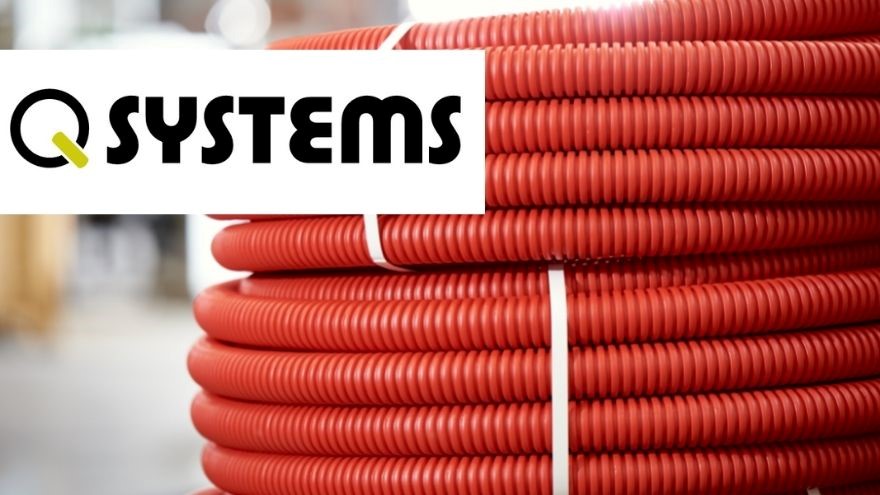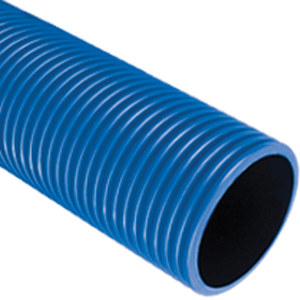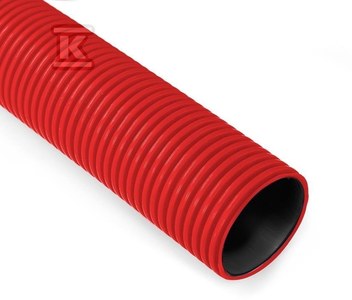The casing pipe system allows for underground cable routing of telecommunications networks. It provides the installation with optimal operating conditions, protecting it against the harmful effects of environmental factors. However, in order to obtain solid cable protection, certain assembly rules must be followed and high-quality materials should be used. What exactly should you remember when implementing such a project?

From this article you will learn:
- how the casing pipe system works,
- what rules to follow when designing and building such a system,
- what pipes to use to protect various types of cables.
What is a protective pipe system?
Protective pipe systems are also called telecommunications or telecommunications sewage systems. They are systems of pipes running both inside and outside buildings, which are needed for the installation of fiber optic or coaxial cables. Such systems include:
- pipe runs leading outside,
- cable chambers (inspection and storage chambers),
- introductions to buildings.
The casing pipe system is usually based on plastic pipes in various sizes. The most popular diameters are 110 mm, 40 mm and 32 mm. Such cables make up the so-called primary system. At any time, smaller diameter pipes can be inserted into them, which will in turn create a secondary system.
Check out Q-Systems protective pipes at the Onninen wholesaler
 However, it is definitely cheaper and easier to build and operate micro-type systems. They are based on small diameter pipes (e.g. 7 mm or 14 mm), into which cables are inserted using a blowing machine. Individual sections of cables can be connected with appropriate hermetic connectors. This solution allows, among other things, to reduce frictional resistance, reduce road lease fees and extend the sections between wells. However, it is not without its drawbacks - the micro system does not offer much expansion possibilities, as the tube only holds one cable.
However, it is definitely cheaper and easier to build and operate micro-type systems. They are based on small diameter pipes (e.g. 7 mm or 14 mm), into which cables are inserted using a blowing machine. Individual sections of cables can be connected with appropriate hermetic connectors. This solution allows, among other things, to reduce frictional resistance, reduce road lease fees and extend the sections between wells. However, it is not without its drawbacks - the micro system does not offer much expansion possibilities, as the tube only holds one cable.
Principles of building a casing pipe system
There are two ways of running pipes in such a system. The first one is based on a reinforced concrete structure, which includes:
- cable wells,
- cable well tops,
- well covers,
- pipe segments,
- cable supply containers.
The second method involves the use of plastics or laminates. This type of construction includes:
- cable wells,
- cable duct pipes,
- connectors, fittings and other elements for connecting pipes,
- cable supply containers.
Check out Q-Systems protective pipes at the Onninen wholesaler
When building a casing pipe system, several basic rules should be followed to ensure comfortable and trouble-free operation. During the work phase, pay attention to:
- easy access to cables (for possible network reconstruction),
- adequate protection against damage,
- tight pipeline connections,
- durability and capacity (additional space for additional cables if necessary),
- compatibility with all types of cables used in telecommunications,
- protection against access by unauthorized persons,
- laying telecommunications cables at the appropriate depth (easy and safe access).
Telecommunications casing pipe system – guidelines
The regulations regarding casing pipe systems are partly described in Polish standards and partly in the regulation of the Minister of Infrastructure of October 26, 2005 on the technical conditions to be met by telecommunications buildings and their location. The rules for building this type of network can be found primarily in operators' company standards and company and local guidelines.
Primary system
Primary telecommunication sewerage cables should run as straight as possible. It is worth ensuring that their waving both vertically and horizontally does not exceed 0.2-0.3%. It is also necessary to ensure maximum tightness of the installation along its entire length, as well as in places where it connects to wells or buildings.
Primary systems are made of prefabricated concrete elements with a diameter of approximately 110 mm or - increasingly often - of plastic pipes (PE or PVC). In cities, in areas with intensive development, cables are laid mainly in open trenches or using trenchless directional drilling and directional jacking techniques.
Secondary system
When building secondary systems, principles very similar to those used for primary systems apply:
- Pipes must not cross other pipes along their entire length;
- Pipe corrugation should not exceed 0.2-0.3%;
- The bottom of the excavation must be even and hardened;
- Warning tape should be placed halfway down, above the pipes;
- After backfilling the excavation, the soil should be compacted.
Secondary systems are made of HDPE pipes with external diameters of 40 and 32 mm. They can be placed in the primary system ducts (e.g. in areas with intensive development) or directly in the ground.
Exchange benefits in the new OnnTop loyalty platform!
What products should be used when creating casing pipe systems?
The basis of a functional system are high-quality pipes, properly matched to the specificity of a specific installation. When selecting cables for a given network, special attention should be paid to the material from which they are made and its technical properties. The material used should be resistant to difficult environmental conditions and possible mechanical damage. Pipes must protect cables against moisture and the influence of various chemical compounds, as well as against compression.
At the stage of designing and building casing pipe systems, it is worth using reliable products from renowned brands. An example of such an assortment are protective pipes from the Q-Systems offer . In our online wholesale store, you can easily purchase cables that are perfectly suited to the specific nature of the project you are implementing. If you are working on telecommunications installations, be sure to check out the offers available in our online wholesaler. Here you will find products such as:
-
 Red corrugated pipe Q-Systems QRK 110 - corrugated protective pipe in sections to protect cables laid in the ground; characterized by high compression resistance, in accordance with the requirements of PN-EN 61386-24;
Red corrugated pipe Q-Systems QRK 110 - corrugated protective pipe in sections to protect cables laid in the ground; characterized by high compression resistance, in accordance with the requirements of PN-EN 61386-24; - Blue corrugated pipe Q-Systems QRK 40/50 FLEX - corrugated protective pipe in sections to protect cables laid in the ground; supplied with a connector and a rope for easy pulling of the cables; high flexibility, small bending radius, smooth internal wall, high compression resistance, in accordance with the requirements of PN-EN 61386-24;
- Blue split pipe Q-Systems QRD 110 - split pipe, for protecting existing cables and wires, in accordance with the requirements of PN-EN 61386-24;
- Q-Systems QRGS 32 black smooth-wall fiber optic pipe - for covering optical and copper telecommunications cables; co-extruded slip layer.
In the wide range of the Q-Systems brand , you will easily find pipes perfectly suited to the nature of the network you are working on. Stock up on the necessary products and ensure your installations are absolutely reliable!
Do you have questions about the industry? Join the Świat Instalacji group!